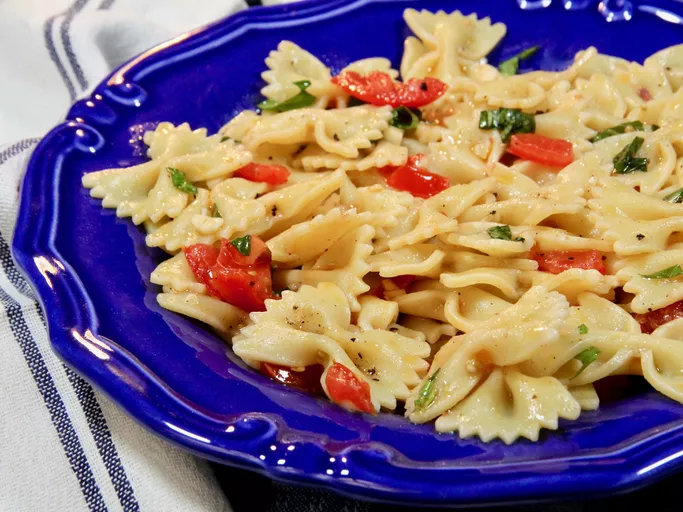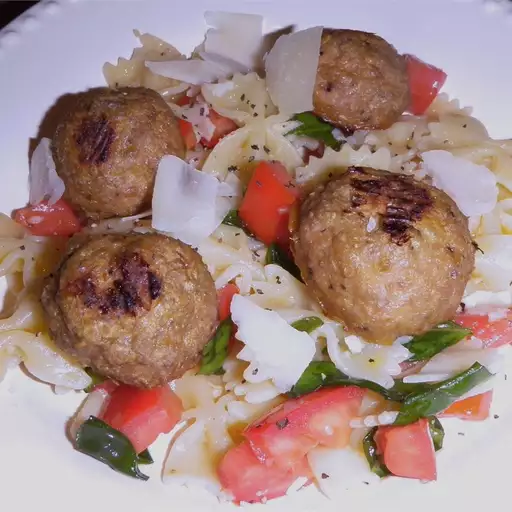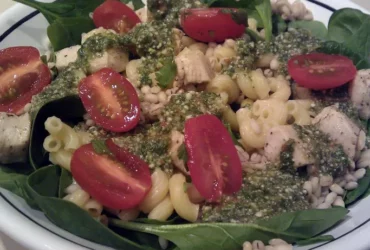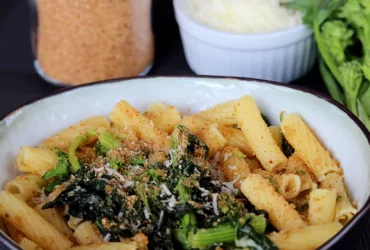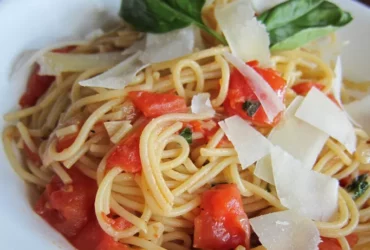Pasta Preparation
Choose the Right Pasta Shape
To create a delicious and satisfying dish like Pasta with a flavorful sauce, it’s essential to begin by selecting the right shape and size of pasta. The chosen shape will not only affect the overall texture and presentation but also how well it pairs with the sauce.
The two primary types of pasta shapes are: long, thin shapes like spaghetti or linguine; and short, tubular shapes such as penne or rigatoni. For our Easy Olive Oil, Tomato, and Basil Pasta Recipe, we will be using a medium-sized penne pasta shape.
Penne is an ideal choice for this recipe because of its angular ends and hollow center, which allows it to hold onto the flavorful sauce. Its moderate length also makes it easy to pair with the ingredients without becoming too overwhelming.
Another significant consideration when selecting a pasta shape is its surface area and hole distribution. For instance, shapes like pappardelle or fettuccine have broad surfaces that can absorb larger quantities of sauce. Conversely, hollow tubes like mostaccioli are better suited for lighter sauces as they will only hold onto the surface oils.
Penning down these factors when choosing a pasta shape allows you to tailor your dish according to your desired texture and overall presentation. Keep in mind that there’s no one-size-fits-all solution, so it’s crucial to experiment with different shapes to find what works best for each unique recipe.
Short, sturdy pasta shapes like penne or rigatoni work best for this recipe
To make the perfect pasta dish, it’s essential to start with the right type of pasta. Short, sturdy shapes such as penne, rigatoni, or even shells work beautifully for this recipe because they hold onto the sauce well.
Here are some key factors to keep in mind when selecting your pasta:
- Choose a shape that has texture and can hold onto chunky ingredients like cherry tomatoes, basil leaves, and grated Parmesan cheese.
- Opt for penne or rigatoni specifically because they have hollow centers that trap the flavorful sauce.
These shapes allow for a good balance of sauce coating and texture
Pasta preparation is an essential step in creating a delicious and satisfying meal, particularly when it comes to a simple yet flavorful recipe like the Easy Olive Oil, Tomato, and Basil Pasta. The type of pasta chosen can greatly impact the overall experience, which is why understanding different shapes and their characteristics is crucial.
For this particular recipe, certain pasta shapes are more suitable than others due to their unique properties. These shapes allow for a good balance of sauce coating and texture in language English, ensuring that each bite is both flavorful and satisfying. Some popular options include:
Fettuccine
A classic choice, fettuccine’s flat shape makes it an ideal candidate for sauces with a moderate to thick consistency, like the olive oil and tomato sauce used in this recipe.
Spaghetti
This long, thin shape is perfect for light, oily sauces that coat the pasta evenly. The smooth texture of spaghetti also complements the flavors of basil and tomatoes beautifully.
Pappardelle
With its wide, flat noodles, pappardelle offers a generous surface area for sauce coating. Its rougher texture adds depth to each bite, making it an excellent choice for hearty sauces like tomato and olive oil.
Linguine
This long, narrow shape is similar to spaghetti but slightly wider. Linguine’s smooth texture and moderate width make it suitable for light to medium-bodied sauces, such as the Easy Olive Oil, Tomato, and Basil Pasta recipe.
Rigatoni
A tubular pasta with ridged ends, rigatoni provides an excellent balance of sauce coating and texture. The ridges trap flavors while the smooth interior allows for a satisfying bite.
When choosing a pasta shape for your Easy Olive Oil, Tomato, and Basil Pasta recipe, consider factors such as sauce consistency, personal preference for texture, and the overall flavor profile you wish to achieve. By selecting the right pasta shape, you’ll be able to bring out the best in this simple yet delicious dish.
Olive Oil Sauce
Sources of Flavor
Olive oil sauce, a staple in many Italian dishes, is a masterclass in simplicity and flavor complexity. At its core, this versatile sauce relies on just three key ingredients: olive oil, garlic, and herbs.
The foundation of any good olive oil sauce is high-quality olive oil. The choice of oil can greatly impact the flavor profile of the final product, with some oils imparting a stronger, peppery taste, while others provide a smoother, more delicate finish. Look for an extra virgin or cold-pressed oil that complements the other flavors in your dish.
Garlic is another crucial component, providing depth and pungency to the sauce. When sautéed in olive oil, garlic mellows out slightly, its flavor becoming nutty and aromatic. This process helps to balance out the boldness of the oil, creating a harmonious blend that’s sure to tantalize your taste buds.
Herbs are the final piece of the puzzle, adding freshness and vibrancy to the sauce. Basil is a classic choice, its bright, slightly sweet flavor pairing perfectly with olive oil and garlic. However, other herbs like parsley, oregano, or thyme can also be used to create unique variations.
Here are some tips for incorporating your chosen herbs into the sauce:
- Use fresh herbs whenever possible; they add a brighter, more complex flavor than dried herbs.
- Parsley adds a slightly bitter note and is perfect for balancing out strong flavors like garlic.
- Oregano brings a pungency similar to garlic, but with a more earthy undertone.
- Thyme pairs well with olive oil and has a subtle, slightly minty flavor that’s perfect for summer dishes.
The ratio of olive oil to herbs can also greatly impact the final product. Some like a strong emphasis on garlic, while others prefer a lighter hand. Experimenting with different proportions will allow you to find your ideal balance and create a sauce that truly reflects your taste preferences.
When combining olive oil, garlic, and herbs in a sauce, there are several methods for achieving the perfect blend. Some people like to slowly sauté their ingredients over low heat, allowing each flavor component to meld together gradually. Others prefer to add all their ingredients at once and cook until they’ve reached the desired consistency.
Ultimately, the choice of method depends on your personal preference and the type of dish you’re creating. Here are a few options for combining olive oil sauce ingredients:
- Add garlic and herbs to the pan with olive oil and sauté over low heat, stirring frequently, until the mixture reaches your desired consistency.
- Combine all ingredients at once in a small bowl or measuring cup, whisking them together until smooth, then adding them directly to the pasta.
- Create a sauce base by cooking garlic and herbs in olive oil for 2-3 minutes before gradually adding other ingredients and seasoning to taste.
Whichever method you choose, remember to taste as you go and adjust your seasoning accordingly. This ensures that each component of the sauce is balanced and working together harmoniously, resulting in a final product that’s nothing short of exceptional.
Extra virgin olive oil is the star of the show in this recipe, providing a rich and fruity flavor
The beauty of a well-made olive oil sauce lies in its simplicity and elegance. It’s a perfect condiment for pasta dishes, allowing the natural flavors of the ingredients to shine through without overpowering them.
For this recipe, extra virgin olive oil is the star of the show, providing a rich and fruity flavor that enhances the overall taste experience. The quality of the olive oil is crucial here, as it directly impacts the final result.
To start making this delicious sauce, heat a couple of tablespoons of high-quality extra virgin olive oil in a pan over medium-low heat. This gentle warmth will help bring out the nuances of the oil without burning or scorching it.
Once the oil is warm and fragrant, add some chopped garlic to the pan and let it simmer for a minute or two until it’s softened and lightly golden. Be cautious not to burn the garlic, as this can create an unpleasant flavor.
Next, add in the sliced tomatoes – preferably fresh and flavorful ones, such as cherry tomatoes or heirloom varieties – to the pan with the olive oil and garlic. Let them simmer for about 5-7 minutes, stirring occasionally, until they release their juices and start to break down.
Add a handful of chopped fresh basil leaves to the pan, and stir well to combine with the tomato mixture. The fragrance of the basil will infuse into the sauce, creating an aromatic flavor profile that complements the sweetness of the tomatoes.
Continue cooking the sauce for another 5-7 minutes, stirring occasionally, allowing it to thicken and reduce slightly as it cooks. This is where the magic happens, and the flavors meld together in harmony.
To finish this amazing olive oil sauce, simply season with salt, pepper, and a pinch of sugar to taste. Be careful not to over-season, as the delicate flavor of the extra virgin olive oil should shine through.
Now it’s time to bring everything together by tossing cooked pasta – such as spaghetti or linguine – in this delectable olive oil sauce, topped with some grated Parmesan cheese and a sprinkle of fresh basil leaves for garnish. Buon appetito!
According to the USDA, extra virgin olive oil has a distinct sensory profile due to its high polyphenol content
The Extra Virgin Olive Oil used in this recipe has a distinct sensory profile, thanks to its high polyphenol content, as noted by the USDA.
Polyphenols are powerful antioxidants found in Olive Oil that contribute to its characteristic flavor and aroma. These compounds are responsible for the bitterness and peppery notes often associated with high-quality olive oil.
In the context of this recipe, the Extra Virgin Olive Oil is used as a key ingredient in creating a rich and flavorful Olive Oil Sauce. To make this sauce, combine 1/2 cup of Cherry Tomatoes, halved, with 1/4 cup of Extra Virgin Olive Oil, 2 cloves of minced garlic, and a handful of fresh basil leaves in a small bowl.
Allow the mixture to sit at room temperature for at least 30 minutes to allow the flavors to meld together. This process is known as infusion, where the Olive Oil absorbs the flavors and aromas of the other ingredients.
The resulting sauce has a vibrant green color, thanks to the presence of fresh basil leaves, and a rich, savory flavor that complements the pasta perfectly. The Extra Virgin Olive Oil adds a subtle depth to the dish, while the Tomato provides natural sweetness.
The combination of these ingredients creates a harmonious balance of flavors in this Easy Olive Oil, Tomato, and Basil Pasta Recipe that is sure to please even the most discerning palates.
Tomato, Basil, and Pasta Harmony
Creating the Perfect Balance
- The union of tomato, basil, and pasta is a harmonious culinary marriage that has been delighting palates for centuries.
- When executed correctly, this trio can create a dish that’s nothing short of sublime, with each component elevating the others to new heights.
The Key Players: Tomato, Basil, and Pasta
The star of the show is often considered to be the tomato – fleshy, vibrant red, and bursting with juicy flavor. Fresh tomatoes add a depth of flavor and texture that’s impossible to replicate with canned or cooked varieties.
Basil, on the other hand, provides a fragrant and aromatic contrast to the rich taste of tomato. Its piney and slightly sweet undertones complement the savory qualities of pasta and tomato beautifully.
The Secret to Balance: Choosing the Right Pasta Shape
Selecting the perfect pasta shape is crucial in achieving harmony among these three ingredients. Consider using long, thin shapes like spaghetti or linguine, which will allow each component to shine.
- Spaghetti: Long, cylindrical strands that pair well with delicate flavors and sauces.
- Linguine: A flat, narrow shape that complements the rich taste of tomato and basil.
The Perfect Balance: A Simple yet Elegant Recipe
To bring your Tomato, Basil, and Pasta Harmony to life, try this easy olive oil-based recipe:
Ingredients
- 12 oz pasta of choice (spaghetti or linguine)
- 2 cups cherry tomatoes
- 1/4 cup extra virgin olive oil
- 2 cloves garlic, minced
- 1/4 cup chopped fresh basil leaves
- Salt and pepper to taste
Instructions:
- Bring a large pot of salted water to a boil. Cook the pasta according to package instructions.
- In a large skillet, heat olive oil over medium-high heat.
- Add minced garlic and cook for 1-2 minutes or until fragrant.
- Throw in cherry tomatoes and cook for an additional 3-4 minutes, stirring occasionally.
- Toss cooked pasta with the tomato mixture, basil leaves, salt, and pepper.
The result is a dish that showcases each component’s unique qualities while creating an unforgettable culinary experience. By choosing the perfect balance of flavors and textures, you’ll be well on your way to becoming a master of Tomato, Basil, and Pasta Harmony.
Fresh basil adds a bright and herbaceous note that complements the tomatoes and pasta
The harmony between tomato, basil, and pasta is a classic combination that has been enjoyed for centuries in Italian cuisine. When done correctly, this trio can create a dish that is both simple yet elegant, making it perfect for a weeknight dinner or a special occasion.
The key to achieving this harmony lies in the freshness of the ingredients. Fresh basil adds a bright and herbaceous note that complements the tomatoes and pasta beautifully. The slight bitterness of the basil helps to balance out the natural sweetness of the tomatoes, while its pungency enhances the overall flavor profile of the dish.
The quality of the tomatoes is also crucial in creating this harmony. Heirloom or cherry tomatoes are ideal for their vibrant colors and intense flavors. They should be sliced or halved to showcase their beauty on the plate, and then tossed with the pasta, basil, and a drizzle of high-quality olive oil.
The pasta itself can vary depending on personal preference, but traditionally, long, thin shapes such as spaghetti or fettuccine are used. The key is to choose a shape that will hold onto the sauce without becoming too clumpy or overwhelming. In this case, a light coating of olive oil allows each strand of pasta to absorb the flavors without becoming heavy.
The harmony between tomato, basil, and pasta is also about balance. Too much basil can overpower the dish, while too few tomatoes can make it taste bland. The key is to find that perfect balance where each ingredient enhances the others without dominating the flavor profile.
Finally, the olive oil used in this recipe is essential for bringing everything together. A high-quality extra-virgin olive oil adds a richness and depth of flavor to the dish that complements the tomatoes and basil beautifully. It’s best to use it as the finishing touch, drizzling it over the pasta just before serving.
In conclusion, the harmony between tomato, basil, and pasta is a classic combination that requires balance, freshness, and quality ingredients. By using the freshest basil, heirloom tomatoes, and high-quality olive oil, you can create a dish that is both simple yet elegant, making it perfect for any occasion.
According to Harvard Health Publishing, combining herbs with olive oil can enhance their flavors and aromas
The harmony between tomato, basil, and pasta is a culinary match made in heaven. In fact, this classic combination has been a staple in Italian cuisine for centuries, with each ingredient complementing the others to create a dish that is both simple and yet richly flavorful.
According to Harvard Health Publishing, combining herbs with olive oil can enhance their flavors and aromas. When it comes to basil and tomato pasta, this principle holds true. The fresh, herbaceous flavor of basil pairs beautifully with the sweet, tangy taste of tomatoes, while the richness of olive oil brings everything together.
The reason why this combination works so well lies in the chemistry between the ingredients. Basil contains a compound called linalool, which is responsible for its distinct aroma and flavor. When linalool interacts with tomato’s natural sugars and acids, it enhances the sweetness of the tomatoes and balances out their acidity.
Meanwhile, olive oil plays a crucial role in bringing all these flavors together. Its high levels of antioxidants help to stabilize the flavor compounds in basil, allowing them to last longer on the palate. At the same time, olive oil’s mild, fruity flavor complements the natural sweetness of tomatoes without overpowering it.
When preparing your Easy Olive Oil, Tomato, and Basil Pasta Recipe, be sure to use high-quality ingredients. Choose a ripe tomato that is heavy for its size and has a sweet aroma. Fresh basil leaves should be bright green with no signs of wilting or browning. And, of course, opt for extra-virgin olive oil for its rich flavor and numerous health benefits.
To cook the pasta al dente, bring a large pot of salted water to a boil and add your chosen type of pasta. Cook according to package instructions until it’s slightly firm in the center. Reserve 1 cup of pasta water before draining and setting aside.
In a large skillet or sauté pan, heat a couple of tablespoons of olive oil over medium heat. Add minced garlic and cook for about a minute, until fragrant. Then, add chopped fresh basil leaves and cook for another minute, stirring occasionally to prevent burning.
Add the reserved pasta water to the skillet with the basil and garlic mixture, followed by the cooked pasta. Toss everything together to coat the pasta evenly with the herb-infused olive oil sauce. Season with salt, pepper, and a sprinkle of grated Parmesan cheese for added depth of flavor.
- Best Lusha Alternatives for 2025 - April 22, 2025
- Best Overloop Alternatives for 2025 - April 22, 2025
- Best 6sense Alternatives for 2025 - April 22, 2025

